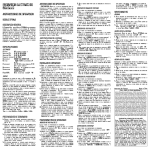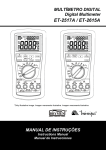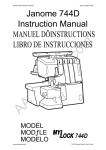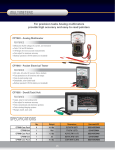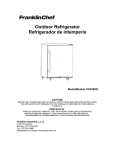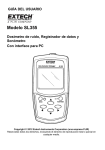Download Actron CP7848 Operating Instructions
Transcript
POCKET ELECTRICAL TESTER 10K 5K 200 60 40 10 8 20 30 6 5 4 3 2 1K 100 1 50 10 2 200 40 8 A FUSE & DIODE PROTECTION +20 ? G OO 60% D +22 70% BAT 110% DC 10000 / V AC 40000 / V CP7848 V AC 10 V dB CE dB PLA RE 10 -20 +16 +18 +12 AC +8 250 50 10 A V•m V•m 150 30 6 100 20 4 AC V 0dB: RANGE 1mW 600 10 50 250 1000 ADD dB 0 14 28 40 ® CP7848 by OFF 1000 DC V 1000 250 AC V 250 50 50 2.5 10 X1K 10 X10 250 DCmA 1.5V 9V BAT OHM OPERATING INSTRUCTIONS Instrucciones en Español e Inglés GENERAL DESCRIPTION The CP7848 Pocket Analog Tester is a rugged, accurate, easy to operate, compact instrument. The stable linear meter movement of the tester allow it to make accurate measurements of AC and DC voltages, DC currents in the milliamp range, resistance, and decibels. The tester uses the most modern components and circuit techniques de signed in a high impact case. If the tester is kept clean and is not subjected to extreme shock or continuous vibration, it will provide many years of trouble free service. SPECIFICATIONS ELECTRICAL Range: 18 measuring ranges DC voltage: 0 2.5 50 250 1000volts AC voltage: 0 10 50 250 1000volts DC current: 0 10 250 mA Resistance: OHM X10, OHM X1K Decibel: 20dB to 62dB at AC volt ranges Accuracies: DC V/A 4% Full Scale, AC V 5% Full Scale Resistance: 4 Arc of scale length Sensitivity: 10,000 Ohms/VDC, 4,000 Ohms/VAC BAT test: 1.5V, or 9V batteries PHYSICAL Function range switch: A 14 position switch located at the center of the tester. This switch is used to select the func tion and range to be measured. Zero Adjuster: A thumbwheel adjustment located on the left side of the tester. The zero adjuster is used to zero the meter pointer when making resistance measurements. Mechanical adjuster: A screw located directly below the center of the meter scale. The mechanical adjuster is used to set the meter pointer to the Zero mark at the left side of the black scale. Negative ( ) jack: Plug in connector located at the lower left corner of the tester. The BLACK or negative( ) test lead is always inserted in this jack. 0002-012-2172 Positive ( ) jack: Plug in connector located at the lower right corner of the tester. The RED or positive( ) test lead is always inserted in this jack. Power supply: One 1.5V, size AA cell battery for Ohm meter. Size & Weight: 5 3/4 x 2 1/2 x 1 1/4 , 136g. 10. If excessive voltage or current is accidentally applied on a certain range, disconnect the leads from the circuit as quickly as possible. Check the tester operation on that range by applying an appropriate input. If the tester does not operate properly, check the fuse; if it is blown, re place it. (See Fuse Replacement) SAFETY PRECAUTIONS OPERATING PROCEDURES 1. Always visually inspect the tester, test leads, and circuit under test for damage prior to every use. 2. Turn off power and discharge any capacitors and induc tors prior to connecting or removing test leads from an electrical circuit or electronic equipment. 3. Always keep yourself isolated from an electrical circuit when making measurements. When possible use one hand to make measurements. 4. Never allow yourself to be grounded when making elec trical measurements. Stand on a rubber mat, wear dry clothing, use insulated test probes, and be careful of all exposed metal when making electrical measurements. 5. Never hold tester when making electrical measurements. Place the tester on a clean insulated surface before mak ing any electrical measurements. OPERATING INSTRUCTIONS CAUTION ! When making voltage or current measure ments, form the habit of turning off all power to the cir cuit under test, and discharge any capacitors and induc tors. Connect the test leads at the desired points in the circuit and then turn on the power while taking readings. Turn off the power and discharge any capacitors and in ductors, before disconnecting the test leads from the cir cuit. PRELIMINARY ADJUSTMENTS Adjust the meter pointer to the Zero mark at the left side of the black scale before making any measurements. First, check to see if the meter pointer indicates Zero at the ex treme left end of the black scale. If it is off Zero, use a small screwdriver to turn the mechanical adjuster screw on the meter movement slowly CW (clockwise) or CCW (counterclockwise) until the meter pointer is exactly over the Zero mark. INTERNAL BATTERY CHECK Important: A 1.5V AA cell battery must be installed before using the CP7848. (See Battery Replacement) In order to check the battery condition, insert the black test lead into the ( ) negative jack, and insert the red test lead into the ( ) positive jack. Set the function range switch to the OHM X10 position and touch the ends of the two test leads together. Rotate the Zero Adjuster thumbwheel lo cated on the left side of the tester until the pointer indi cates Zero on the green ohms scale. If the pointer cannot be brought to the Zero mark, replace the 1.5 volt size AA cell battery. (See Battery Replacement) OPERATING SUGGESTIONS 1. Set the range switch to the proper position before tak ing any measurement. 2. Never apply more voltage or current than the amount noted in each position. 3. When the voltage or current to be measured is not known, always start with the highest range in each case. 4. If the meter pointer is in the lower half of the scale and falls within the range of a lower function range switch position, then rotate the function range switch to the lower range for greatest accuracy. 5. If none of the tester functions work at all, check the fuse located inside the tester on the printed circuit board. If the fuse is blown, replace it. (See Fuse Replacement) 6. Avoid placing the tester in a place where severe vibra tion is encountered; Do not store it in excessively hot or damp places! 7. Do not check resistance when voltage or current is present in the circuit. 8. Discharge a capacitor before measuring it. 9. When the tester is not in use, keep the function range switch in the OFF position. This provides a direct short across the meter movement, stabilizing the needle for minimum needle bounce when transporting the tester. DC VOLTAGE MEASUREMENT 1. Read all SAFETY PRECAUTIONS. 2. Set the function range switch to the appropriate DC volt age range. If the voltage is unknown, use the highest range. 3. Insert the BLACK test lead into the ( ) negative jack and the RED test lead into the ( ) positive jack. 4. If the polarity of the circuit to be tested is known, con nect the BLACK probe to the ( ) negative voltage side of the circuit, and the RED probe to the ( ) positive voltage side. 5. If the polarity of the circuit to be tested is not known, connect the probes to opposite sides of the circuit and watch the meter pointer. If the meter pointer deflects to the left, reverse the probes. The RED probe will now be connected to the ( ) positive voltage side. 6. Use the black scale for reading DC voltage measure ments. DC CURRENT MEASUREMENT 1. Read all SAFETY PRECAUTIONS. 2. Set the function range switch to the appropriate DC mA range. If the current is unknown, use the highest range. 3. Insert the BLACK test lead into the ( ) negative jack, and the RED test lead into the ( ) positive jack. 4. Using the test leads, connect the tester in series with the circuit under test. If the meter pointer deflects to the left, reverse the test probes. 5. Use the black scale for reading DC mA measurements. AC VOLTAGE MEASUREMENT 1. Read all SAFETY PRECAUTIONS. 2. Set the function range switch to the appropriate AC volt age range. If the voltage is unknown, use the highest range. 3. Insert the BLACK test lead into the ( ) negative jack and the RED test lead into the ( ) positive jack. 4. Connect the RED and BLACK test probes to opposite sides of the AC voltage source. (Polarity of test probes is unimportant on AC voltage.) 5. Use the red scale for 10V and 1000V AC voltage mea surements. Use the black scale for 50V and 250V AC voltage measurements. DECIBEL 1. Read all SAFETY PRECAUTIONS. 2. Insert the BLACK test lead into the ( ) negative jack, and the RED test lead into the ( ) positive jack. 3. Set the function range switch to the appropriate AC volt age range for the dB range you wish to measure. 4. For a function range switch setting of 10 AC V, read the dB directly from the bottom of the red scale in dB. For other AC V settings of the function range switch, add the appropriate number of dB to the dB scale reading as noted on the chart at the lower right corner of the meter face. RESISTANCE MEASUREMENT 1. Read all SAFETY PRECAUTIONS. 2. Turn off all power in circuit before making resistance measurements. 3. Set the function range switch to the appropriate OHM range. If the resistance is unknown, use the highest range. 4. Insert the BLACK test lead into the ( ) negative jack, and the RED test lead into the ( ) positive jack. 5. Touch the ends of the two test leads together. Rotate the Zero Adjuster thumbwheel located on the left side of the tester until the pointer indicates Zero on the green ohms scale. If the pointer cannot be brought to the Zero mark, replace the 1.5 volt size AA cell battery. (See Battery Replacement) 6. Connect the test probes across the resistance to be measured. 7. Take a reading on the green Ω scale and multiply it by the multiplication factor indicated by the function range switch. Multiply reading by 1K (1000Ω) for the OHM 1K position and, by 10 for the OHM 10 switch position. The units for the OHM 10 position are ohms Ω . 8. If there is little or no meter pointer movement from the left side of the green Ω scale, rotate the function range switch to a higher range in an effort to get a greater de flection of the meter pointer. The most accurate reading on an ohmmeter ranges between the middle of the scale and Zero ohms. BATTERY CHECK 1. Read all SAFETY PRECAUTIONS. 2. Set the selector switch to the appropriate BAT range. 3. Insert the BLACK test lead into the ( ) negative jack, and the RED test lead into the ( ) positive jack. 4. Touch and hold the RED test lead to the ( ) positive bat tery terminal and the BLACK test lead to the ( ) negative battery terminal. 5. Read the BAT scale to determine the battery condition. If the reading is in the red REPLACE zone, the battery should be replaced. If the reading is in the green GOOD zone, the battery has considerable life left. If the reading is in the ? zone, the battery should be replaced soon because the remaining power is very low. MAINTENANCE GENERAL 1. No periodic maintenance is required other than replace ment of the battery, fuse, and visual inspection of the tester. 2. Keep the instrument clean and dry. Do not use solvent for cleaning; use a damp cloth. 3. The only field replaceable parts are the 1.5V AA cell battery and the Fast Acting 5mm X 20mm, 0.315A, 250V fuse. BATTERY REPLACEMENT Important: A 1.5V AA cell battery must be installed before using the CP7848. 1. Rotate the function range switch to the OFF position. 2. Remove red and black test leads from the test lead jacks. 3. Remove screw from rear of tester, and lift off the back cover. 4. Install a new 1.5V AA cell battery. Observe the polarity marks as indicated on the bottom of the battery com partment. 5. Carefully replace the back cover and tighten the screw. Be careful not to over tighten the screw, because the threads in the case may become stripped. FUSE REPLACEMENT Important: If the tester won t work at all, check the fuse located inside the tester. If the fuse is blown, all tester func tions fail to work. 1. Rotate the function range switch to the OFF position. 2. Remove red and black test leads from the test lead jacks. 3. Remove screw from rear of tester, and lift off the back cover. 4. Replace blown fuse with a new Fast Acting 5mm X 20mm, 0.315A, 250V fuse. 5. Carefully replace the back cover and tighten the screw. Be careful not to over tighten the screw, because the threads in the case may become stripped. PROBADOR ELECTRICO DE BOLSILLO INSTRUCCIONES DE OPERACION MODELO CP7848 DESCRIPCION GENERAL El Probador Anal gico de Bolsillo CP7848 es un instrumento compacto s lido, preciso, f cil de operar. El movimiento linear estable del medidor del probador permite efectuar mediciones precisas de voltajes de CC y CA, corrientes de CC en la gama de miliamperes, resistencia y dec beles. El probador usa los componentes m s modernos y t cnicas de circuito dise ados en una caja de alto impacto. El probador proveer muchos a os de servicio libres de problemas, si se mantiene limpio y no se sujeta a choques extremos o vibraciones continuas. ESPECIFICACIONES ELECTRICAS Alcance: Voltaje de CC: Voltaje de CA: Corriente continua: Resistencia: Dec bel: Precisiones: Resistencia: Sensibilidad: Prueba BAT: 18 alcances de medici n 0 2,5 50 250 1000V 0 10 50 250 1000V 0 10 250 mA OHMIO X 10, OHMIO X 1K 20dB a 62dB a los alcances de V de CA V/A CC 4% a escala completa, V CA 5% a escala completa Arco de 4 de la longitud de la escala 10,000 Ohmios/VCC 4,000 Ohmios/VCA Bater as con tensi n de 1,5V 9V FISICAS Interruptor de alcance de funci n: Un interruptor de 14 posiciones ubicado en el centro del probador. Este interruptor se usa para seleccionar la funci n y alcance a medir. Ajustador a cero: Un ajuste por rueda accionada a pulgar ubicado en el lado izquierdo del probador. El ajustador a cero se usa para graduar a cero el puntero medidor al efectuar mediciones de resistencia. Ajustador mec nico: Un tornillo ubicado directamente debajo del centro de la escala de medida. El ajustador mec nico se usa para graduar el puntero medidor a la marca Cero a la izquierda de la escala negra. Clavija negativa ( ): Conector de enchufe ubicado en la esquina izquierda inferior del probador. La gu a de prueba NEGRA o negativa ( ) est siempre insertada en este clavija. Clavija positiva ( ): Conector de enchufe ubicado en la esquina derecha inferior del probador. La gu a ROJA de prueba o positiva ( ) est siempre insertada en este clavija. Suministro de potencia: Una bater a con tensi n de 1,5V tama o AA, para el ohm metro. Tama o y peso: 14,60cm x 6,35cm x 3,18cm / 136g PRECAUCIONES DE SEGURIDAD 1. Previo a cada uso, siempre inspeccione visualmente el probador, las gu as de prueba, y el circuito a prueba, por da os. 2. Antes de conectar o retirar las gu as de prueba de un circuito el ctrico o equipo electr nico, desconecte la potencia y descargue los condensadores e inductores. 3. Al efectuar mediciones mant ngase siempre aislado de los circuitos el ctricos. Siempre que sea posible use una sola mano para efectuar las mediciones. 4. Al efectuar mediciones el ctricas tenga mucho cuidado en no estar conectado a tierra. Al efectuar mediciones el ctricas, p rese sobre una alfombrilla de goma, use ropa seca, use sondas de prueba aisladas, y tenga cuidado con el metal expuesto. 5. Al efectuar mediciones el ctricas, nunca sostenga el probador. Antes de efectuar mediciones el ctricas, coloque el probador sobre una superficie limpia aislada. INSTRUCCIONES DE OPERACION PRECAUCION! Adopte el h bito de desconectar toda la potencia al circuito a prueba y descargar todos los condensadores e inductores, al efectuar mediciones de voltaje o corriente. Conecte las gu as de prueba a los puntos deseados del circuito y conecte la potencia mientras efect a las mediciones. Antes de desconectar las gu as de prueba del circuito, desconecte la potencia y descargue todos los condensadores e inductores. AJUSTES PRELIMINARES Antes de efectuar cualquier medici n, ajuste el puntero del medidor a la marca Cero a la izquierda de la escala negra. Primero inspeccione para ver si el puntero medidor indica Cero al extremo izquierdo de la escala negra. Si est fuera de cero, use un peque o destornillador para girar lentamente el tornillo del ajustador mec nico del movimiento del medidor en el sentido de las agujas del reloj o en sentido contrario de las agujas del reloj hasta que el puntero medidor est exactamente sobre la marca Cero. INSPECCION INTERNA DE LA BATERIA Importante: Antes de usar el Modelo CP7848 debe usarse una bater a con tensi n de 1,5V AA (Vea Reemplazo de la bater a) Inserte la gu a negra de prueba en la clavija negativa ( ) e inserte la gu a roja de prueba en la clavija positiva ( ), para inspeccionar la condici n de la bater a. Grad e el interruptor de alcance de funci n a la posici n de OHMIO X 10 y junte los extremos de las dos gu as de prueba. Gire la rueda accionada por pulgar del Ajustador a Cero ubicada en el lado izquierdo del probador hasta que el puntero indique Cero en la escala verde de ohmios. Reemplace la bater a con tensi n de 1,5 V de tama o AA , si el puntero no puede llevarse a la marca Cero. (Vea Reemplazo de la bater a) CONSEJOS DE OPERACION 1. Grad e el interruptor de alcance a la posici n apropiada antes de efectuar cualquier medici n. 2. Nunca aplique m s voltaje o corriente que la cantidad notada en cada posici n. 3. Siempre comience con el alcance mayor en cada caso, cuando no se conoce el voltaje o la corriente a medir. 4. Gire el interruptor de alcance de funci n al alcance infe rior para m s exactitud, si el puntero medidor est en la mitad inferior de la escala y cae dentro del alcance de una posici n inferior del interruptor de alcance de funci n. 5. Inspeccione el fusible ubicado dentro del probador en el tablero del circuito impreso, si ninguna de las funciones operan. Reemplace el fusible si est quemado. (Vea Reemplazo del fusible) 6. Evite colocar el probador en un lugar donde se encuentre una vibraci n pronunciada. No lo almacene en lugares excesivamente calientes o h medos! 7. No inspeccione la resistencia cuando est presente voltaje o corriente en el circuito. 8. Descargue los condensadores antes de medirlos. 9. Mantenga el interruptor de alcance de funci n en la posici n OFF cuando el probador no est en uso. Esto provee un cortocircuito directo a trav s del movimiento del estabilizador. estabilizando la aguja para un rebote m nimo de la aguja al transportar el probador. 10. Desconecte las gu as del circuito tan r pido como sea posible, si se aplica accidentalmente voltaje o corriente excesivos en cierto alcance. Inspeccione la operaci n del probador en ese alcance aplicando una alimentaci n apropiada. Inspeccione el fusible si el probador no opera apropiadamente y reempl celo si est quemado. (Vea Reemplazo del fusible) PROCEDIMIENTOS DE OPERACION MEDICION DE VOLTAJE DE CC 1. Lea todas las precauciones de seguridad. 2. Grad e el interruptor de alcance de funci n al alcance apropiado del voltaje de CC Use el alcance m ximo si el voltaje es desconocido. 3. Inserte la gu a NEGRA de prueba en la clavija negativa ( ) y la gu a ROJA de prueba en la clavija positiva ( ). 4. Conecte la sonda NEGRA al lado negativo ( ) del voltaje y la sonda ROJA al lado positivo ( ) del voltaje, si se conoce la polaridad del circuito a probarse. 5. Conecte las sondas a los lados opuestos del circuito y observe el puntero medidor, si no se conoce la polaridad del circuito a probarse. Invierta las sondas si el puntero medidor se mueve hacia la izquierda. La sonda ROJA estar conectada ahora al lado positivo ( ) del voltaje. 6. Use la escala negra para leer las mediciones de voltaje de CC. MEDICION DE CORRIENTE CONTINUA 1. Lea todas las precauciones de seguridad. 2. Grad e el interruptor de alcance de funci n al alcance apropiado de mA de CC Use el alcance m ximo si la corriente es desconocida. 3. Inserte la gu a NEGRA de prueba en la clavija negativa ( ) y la gu a ROJA de prueba en la clavija positiva ( ). 4. Conecte el probador en serie con el circuito a prueba, usando las gu as de prueba. Invierta las sondas de prueba si el puntero medidor se mueve hacia la izquierda. 5. Use la escala negra para leer las mediciones de mA de CC. MEDICION DEL VOLTAJE DE CA 1. Lea todas las precauciones de seguridad. 2. Grad e el interruptor de alcance de funci n al alcance apropiado de voltaje de CA Use el alcance m ximo si el voltaje es desconocido. 3. Inserte la gu a NEGRA de prueba en la clavija negativa ( ) y la gu a ROJA de prueba en la clavija positiva ( ). 4. Conecte las sondas ROJA y NEGRA de prueba a los lados opuestos de la fuente de voltaje de CA. (La polaridad de las sondas de prueba no es importante en el voltaje de CA). 5. Use la escala roja para las mediciones de voltaje de 10V y 1000V de CA Use la escala negra para las mediciones de voltaje de 50V y 250V de CA. MEDICION DE DECIBELES 1. Lea todas las precauciones de seguridad. 2. Inserte la gu a NEGRA de prueba en la clavija negativa ( ), y la gu a ROJA de prueba en la clavija positiva ( ). 3. Grad e el interruptor de alcance de funci n al alcance apropiado de voltaje de CA para el alcance de dB que usted desee medir. 4. Para una graduaci n de interruptor de alcance de funci n de 10 V CA, lea los dB directamente del fondo de la escala roja en dB. Para otras graduaciones de V CA del interruptor de alcance de funci n agregue la cantidad apropiada de dB a la lectura de la escala de dB seg n se indica en la tabla de la esquina inferior derecha de la faz del medidor. MEDICION DE LA RESISTENCIA 1. Lea todas las precauciones de seguridad. 2. Antes de efectuar las mediciones de resistencia desconecte toda la potencia al circuito. 3. Grad e el interruptor de alcance de funci n al alcance apropiado de OHMIO. Use el alcance m ximo si la resistencia es desconocida. 4. Inserte la gu a NEGRA de prueba en la clavija negativa ( ) y la gu a ROJA de prueba en la clavija positiva ( ). 5. Junte los extremos de las dos gu as de prueba. Gire la rueda accionada por pulgar del Ajustador a Cero ubicada en el lado izquierdo del probador hasta que el puntero marque cero en la escala verde de ohmios. Reemplace la bater a de 1,5V de tama o AA , si el puntero no puede llevarse a la marca cero. (Vea Reemplazo de la bater a) 6. Conecte las sondas de prueba a trav s de la resistencia a medirse. 7. Tome una lectura en la escala verde de y multipl quela por el factor multiplicador indicado por el interruptor de alcance de funci n. Multiplique al lectura por 1K (1000 ) para la posici n 1K de OHMIO y por 10 para la posici n del interruptor de OHMIO 10. Las unidades para la posici n OHMIO 10 son ohmios . 8. Gire el interruptor de alcance de funci n a un alcance mayor para obtener un movimiento mayor del puntero medidor, si hay poco o nada de movimiento del puntero medidor desde el lado izquierdo de la escala verde . La lectura m s precisa en un ohm metro es desde la mitad de la escala a cero ohmios. INSPECCION DE LA BATERIA 1. Lea todas las precauciones de seguridad. 2. Grad e el interruptor del selector en el alcance BAT apropiado. 3. Inserte la gu a NEGRA de prueba en la clavija negativa ( ) y la gu a ROJA de prueba en la clavija positiva ( ). 4. Tome y mantenga la gu a ROJA de prueba en el terminal positiva ( ) de la bater a y la gu a NEGRA de prueba en el terminal negativa ( ) de la bater a. 5. Lea la escala BAT para determinar la condici n de la bater a. La bater a debe reemplazarse si la lectura est en la zona roja de REPLACE ( REEMPLACE ). La bater a tiene todav a una duraci n considerable si la lectura est en la zona verde GOOD ( BUENA ). La bater a debe reemplazarse pronto ya que al potencia restante es muy d bil, si la lectura est en la zona ? . MANTENIMIENTO GENERAL 1. No se requiere un mantenimiento peri dico m s que el reemplazo de la bater a y del fusible y la inspecci n vi sual del probador. 2. Mantenga el instrumento limpio y seco. Para limpiar no use solvente, use un trapo h medo. 3. Las nicas piezas reemplazables en el campo son la bater a con tensi n de 1,5V AA y el fusible de acci n r pida de 5mm x 20mm / 0,315A / 250V. REEMPLAZO DE LA BATERIA Importante: Antes de usar el Modelo CP7848, debe instalarse una bater a con tensi n de 1,5V AA 1. Gire el interruptor de alcance de funci n a la posici n OFF . 2. Retire las gu as roja y negra del gu a de prueba de las clavijas de gu a de prueba. 3. Retire el tornillo de la parte posterior del probador, y levante la cubierta posterior. 4. Instale una nueva bater a con tensi n de 1,5V AA Observe las marcas de polaridad seg n indicado en el fondo del compartimento de la bater a. 5. Vuelva a colocar cuidadosamente la cubierta posterior y ajuste el tornillo. Sea cuidadoso en no ajustar excesivamente el tornillo, ya que pueden da arse las roscas de la caja. REEMPLAZO DEL FUSIBLE Inspeccione el fusible colocado dentro del probador, si el probador no funciona. Si el fusible est quemado no operan ningunas de las funciones del probador. 1. Gire el interruptor de alcance de funci n a la posici n OFF . 2. Retire las gu as roja y negra de prueba de las clavijas de gu as de prueba. 3. Retire el tornillo de la parte posterior del probador, y levante la cubierta posterior. 4. Reemplace el fusible quemado con un fusible de acci n r pida de 5mm x 20mm / 0,315A / 250V. 5. Vuelva a colocar cuidadosamente la cubierta posterior y ajuste el tornillo. Sea cuidadoso en no ajustar excesivamente el tornillo, ya que pueden da arse las roscas de la caja. Importador: Ver Producto Hecho en China FULL ONE (1) YEAR WARRANTY Actron Manufacturing Company, 15825 Industrial Parkway, Cleveland, Ohio 44135, warrants to the user that this unit will be free from defects in materials and workmanship for a period of one (1) year from the date of original purchase. Any unit that fails within this period will be repaired without charge when returned to the Factory. Actron requests that a copy of the original, dated sales receipt be returned with the unit to determine if the warranty period is still in effect. This warranty does not apply to damages caused by accident, alterations, or improper or unreasonable use. Expendable items, such as batteries, fuses, lamp bulbs, flash tubes also are excluded from the scope of this warranty. ACTRON MANUFACTURING COMPANY DISCLAIMS ANY LIABILITY FOR INCIDENTAL OR CONSEQUENTIAL DAMAGES FOR BREACH OF ANY WRITTEN WARRANTY ON THE UNIT. Some states do not allow the disclaimer of liability for incidental or consequential damages, so the above disclaimer may not apply to you. This warranty gives specific legal rights, and you may also have rights which vary from state to state. GARANTIA COMPLETA DE UN AÑO Actron Manufacturing Company, 15825 Industrial Parkway, Cleve land, Ohio 44135, EE.UU., garantiza al usuario que esta unidad estar libre de defectos de materiales y mano de obra por un (1) a o a partir de la fecha de compra del comprador original. Cualquier unidad que falle dentro de este per odo ser reparada a opci n de Actron sin cargo cuando se devuelva a la f brica. Actron requiere que un comprobante de compra (recibo de venta) fechado acompa e la unidad para determinar si est en garant a. Esta garant a no es aplicable a da os causados por accidente, alteraciones, usos impropios o no razonables. Art culos consumibles, tales como bater as, fusibles, l mparas y tubos de destello quedan exclu dos de esta garant a. Actron Manufacturing Company rechaza cualquier responsabilidad de da os incidentales o indirectos por incumplimiento de cualquier garant a escrita de la unidad. Algunos estados de los EE.UU. y ciertos pa ses no permiten el rechazo de cualquier responsabilidad de da os incidentales o indirectos, por lo que el rechazo anterior puede no ser aplicable en su caso. Esta garant a concede derechos legales espec ficos y es posible que Ud. tenga otros derechos que var an de estado a estado en los EE.UU. y de pa s a pa s. (Garant a V lida solo en EUA)
This document in other languages
- español: Actron CP7848


